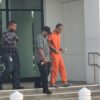While the TSA touts body scanners as innovative technology that serves to minimize security issues and deter crime, the agency has also been denounced by critics for invasion of privacy and safety issues.
According to a handout provided by TSA, the “backscatter advanced imaging technology,” or AIT, is a device that “safely” screens passengers for both metallic and non-metallic threats, including weapons and explosives.
The body scanners allow TSA to screen without physical contact, the handout states.
Optional
TSA said all passengers may opt out of getting a full-body scan, but will be subjected to alternative screening, including physical contact such as a thorough pat-down.
Those who choose to go through the imaging technology will be asked to remove all objects from their pockets before entering the portal. Only one security officer in a walled-off location will be able to view the black and white images generated by the body scanners. Once the officer determines there are no threats, the image is immediately deleted. The process, TSA said, takes only a few seconds.
Safety
According to TSA, the backscatter technology is safe and has been approved by the Food and Drug Administration’s Center for Devices and Radiological Health, the National Institute of Standards and Technology, and the Johns Hopkins University Applied Physics Laboratory.
The backscatter emits low level X-ray beams over the person to produce a reflection of the body, TSA states, which appears as chalk etchings.
Results from the agencies contend the radiation doses are below those specified by the American National Standards Institute, which is equivalent to two minutes of flight on an airplane.
TSA began implementing the body scanners in 2007 and has since installed at least 500 full-body scanners in 78 airports nationwide.
Currently, TSA has 486 imaging technology units and plans to deploy a total of 450 AIT units in 2010. In addition, President Barack Obama’s Fiscal Year 2011 budget requested funding to purchase and deploy an additional 500 AIT machines.










